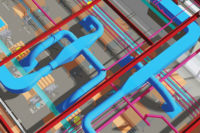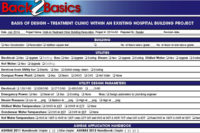At some point in time, most school building committees are given the responsibility to establish a building program to expand their city or town school building assets. For this B2B test, we will be focused on a building committee adding new kindergarten classrooms on to the existing building, allowing the school to reuse the old kindergarten space for a library for students. A Building Program (BP) is created and this document will be the cornerstone for investing in an HVAC design and eventual construction of HVAC systems to meet the Building Program requirements.
The HVAC engineer will take this program information and craft a Basis of Design (BofD) using the suggested BofD template on Page 2 of this B2B. For this month’s test, we have documented the BP for a new kindergarten building addition at the K-6 school in Watford City, ND. On page 2 of this B2B, the reader shall complete the BofD by checking the correct boxes from the multiple choice selections based on the BP information provided herein and from pertinent reference documents, such as local weather data design criteria for this city. The answers to the BofD can be downloaded on the www.esmagazine.com web site.
The new building addition will be a 3,000-sq-ft, one-story structure slab-on-grade. The building will require a special security system that will be integrated with the HVAC system for fire alarm, and it will include TV security cameras at strategic locations. Utilities will be extended out from the existing 24,000–sq-ft school building to provide electricity, gas, and city water to the new space.
Electrical, plumbing, fire protection, and security consultants will work in sync with the HVAC design team to provide a complete mechanical-electrical installation and shall be per state and local codes.
The HVAC electrical requirements shall be 120/1/60 for motors less than .5 hp and 480/3/60 for motors .5 hp and larger. An existing gas-fired 1,300 MBH condensing hot water boiler will provide hot water heating to the kindergarten’s radiant heat floor, central AHU, and four individual fan coil units. The HVAC central air systems shall be direct outside air systems with energy recovery from the dedicated addition exhaust system to provide ventilation to the four spaces that make up the new kindergarten addition. Each room shall be capable of automatically and/or manually being commanded to unoccupied mode along with a morning warm-up and morning cool-down sequences of operation. A central AHU will have an enthalpy airside economizer, with direct expansion cooling and MERV 8 pre-filters and MERV 14 final filters. Fan motors shall include VFD fans to provide outdoor air ventilation to each fan coil unit during occupied cycle and morning cooldown.
The entire building addition will have its floor heated via radiant heat, with the associated fan coil units providing supplemental heat and ventilation. There is no requirement for standby capacity and no system/equipment spare capacity for BP growth.
The HVAC design of this building addition shall be based on State and local codes, as well as the design engineer referring to the ASHRAE 2015 Application Handbook chapter 7 Educational Facilities for basis of design requirements. The design engineer will draw upon the ASHRAE Advanced Energy Design Guide for K-12 School Buildings for more specific energy conservation design opportunities. In addition, reference should be made to ASHRAE 2012 HVAC Systems and Equipment Handbook chapter 54 radiant heating and cooling; also draw upon ASHRAE 2015 Application Handbook and its Building Operation and Management chapters 36 through 43 for additional BofD.
The design engineer, in conjunction with the school building committee and the architect, will finalize the HVAC system to include a closed loop hot water heating system. There will be no air-conditioning requirements. The new central air system and its associated exhaust air system and energy recovery wheels are located on the roof. Fan coil units will be located out of the classroom space for servicing as well as to minimize noise to the occupied rooms.
The HVAC system could be designed for occupied-unoccupied modes of operation Monday through Friday, 7 a.m. to 4 p.m., with manual override if needed. Hot water heating system shall be a fixed 160?F HWS and 130?F HWR during the heating season and the existing boiler will be off when outdoor temperatures reach 60?F. Occupied space shall be maintained at 70?F with no humidity control in the heating season and no summer space temperature control requirements during the air-conditioning season. Equipment room and back-of-the-room support areas will be maintained at 60?F with no humidity control in the heating season.
There will be a LEED Platinum certification requirement with other specialized energy/environmental program criteria based on ASHRAE recommended school guidelines. The reader is directed to the “Facility Files” for the Owner’s Building Program Annual Operating Budget and Operating Program.
As the design phase for this BP goes forward, the BofD should be routinely referenced and updated based on changes in the BP and on any changes and/or enhancements to the HVAC design.





